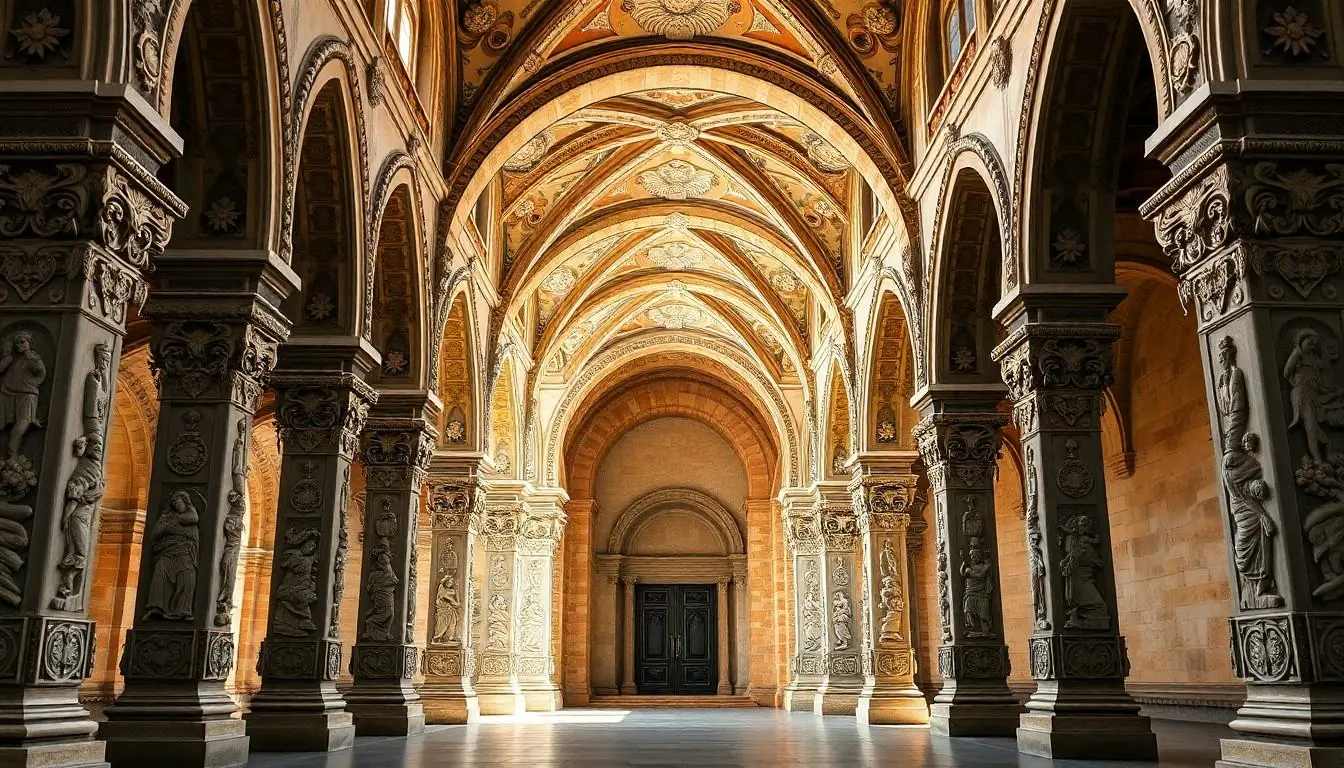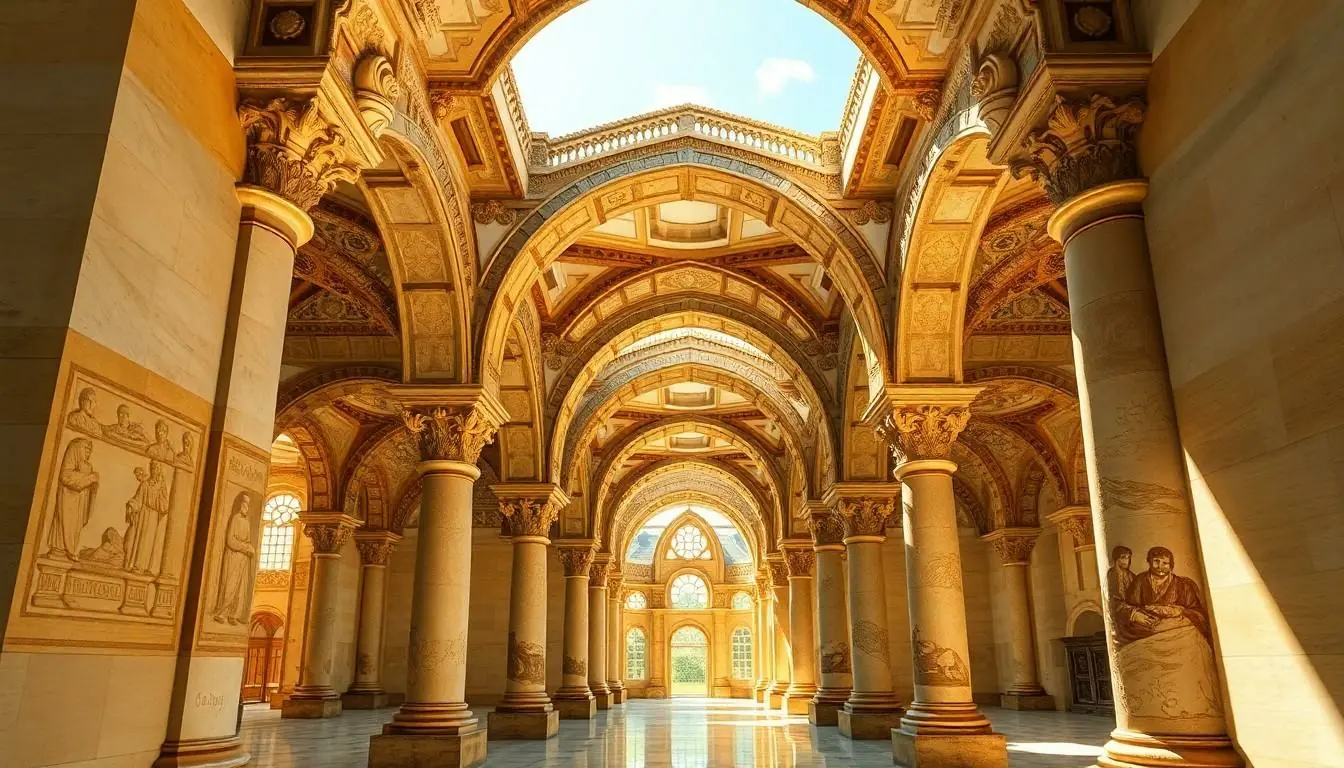Step into the fascinating world of Ottonian architecture, where grand designs and intricate details come together in a delightful dance of history. Among the many architectural wonders of this era, the arcade stands out like a star performer at a talent show. But what exactly is an arcade? Imagine a series of arches gracefully lined up, creating a stunning visual spectacle that not only supports structures but also invites people to stroll beneath its enchanting embrace.
Table of Contents
ToggleOverview of Ottonian Architecture
Ottonian architecture emerged in the 10th and 11th centuries, representing a significant progression in German architectural styles. Characteristic elements include the extensive use of stone, elevated vaults, and decorative features, which reflect the growing power of the Ottonian dynasty. Churches and monasteries often served as the primary structures, showcasing this architectural style’s religious significance.
Attached to this style, the arcade serves as a defining element, consisting of a series of arches supported by columns. Its design enhances the overall aesthetics while providing essential structural support. These arched structures create a harmonious transition between indoor and outdoor spaces, inviting visitors to experience the architecture fully.
With its emphasis on grandeur, Ottonian architecture utilizes intricate sculptures and decorative motifs. Various materials, such as marble and colored stone, often adorned both the exteriors and interiors. Rich patterns and figures depicted biblical scenes that contributed to the spiritual experience within these structures.
Innovations during this period also involved the development of the basilica plan. The layout often includes a long nave, flanked by aisles and divided by columns, enhancing the overall sense of space. Visual emphasis is achieved through large windows, allowing natural light to illuminate the interiors, further highlighting the artistry of the design.
Ottonian architecture signifies a blend of Roman and early Christian influences, setting the foundation for subsequent architectural styles in medieval Europe. Each aspect of this style, from the structural elements to decorative features, reflects both the cultural climate and the aspirations of the Ottonian rulers.
Defining the Arcade

The arcade is a defining feature of Ottonian architecture. This architectural element consists of a series of arches that create an inviting pathway, allowing for both aesthetic enhancement and structural support.
Characteristics of the Arcade
Arches commonly serve as the main component of the arcade. Each arch supports the upper structure while also facilitating movement beneath. Columns or piers frequently support these arches, showcasing intricate carvings and decorations. The spacing of these arches promotes light and ventilation throughout the structure. Decorative elements often include floral motifs and biblical scenes, which enrich the visual experience and reflect religious themes.
Historical Significance
The arcade holds substantial historical importance in Ottonian architecture. It symbolizes a transition into a more complex architectural style during the 10th and 11th centuries. This feature encapsulates the cultural context of the Ottonian dynasty’s power and its influence on ecclesiastical architecture. Religious structures relied on the arcade to combine functionality with artistry, thus enhancing the spiritual atmosphere within churches and monasteries. The adoption of the arcade also marked a revival of classical Roman elements, signifying a return to grandeur and sophistication in medieval architecture.
Architectural Elements of the Arcade
The arcade comprises essential structural and decorative components that define the Ottonian architectural style. This feature contributes significantly to both functionality and aesthetic appeal within religious structures.
Structural Components
Arches serve as the primary structural elements of the arcade. These arches, supported by columns or piers, create a sense of openness and lightness. Space between each arch allows light to filter through, enhancing the atmosphere. Columns often feature intricate carvings that reflect both artistry and craftsmanship. Piers, used occasionally instead of columns, also provide robust support. Stability is a key aspect, ensuring the structural integrity of the building while maintaining a visually striking design.
Decorative Features
Decorative elements play a vital role in the aesthetic richness of the arcade. Floral motifs frequently adorn the capitals of columns, adding organic beauty to the overall design. Biblical scenes, carved or painted, offer spiritual narratives that engage worshippers. The use of colored stone and marble enhances vibrancy, while intricate patterns draw the eye and invite closer inspection. These features reflect the artistic ambitions of the Ottonian dynasty, showcasing a blend of visual storytelling and architectural elegance. Richly adorned arcades contribute to a captivating atmosphere, reinforcing the sacred purpose of these spaces.
Examples of Arcades in Ottonian Architecture
Arcades in Ottonian architecture showcase remarkable craftsmanship and design. Structures featuring these arcades exemplify the period’s religious and artistic significance.
Notable Structures
One significant example is the Abbey Church of Saint Michael in Hildesheim. This church features a series of arcades that create an inviting atmosphere while supporting the upper levels. Another notable structure is the Cathedral of Worms, showcasing elaborate arcades adorned with intricate carvings. These arcades enhance both the aesthetic elegance and structural integrity of the buildings, marking the importance of such designs in Ottonian architecture.
Regional Variations
Regional variations in Ottonian arcades appear in different areas of Germany. In some regions, the use of brick rather than stone for arcades became prevalent, reflecting local material availability. Some churches exhibit wider arches, allowing for greater spaciousness inside, while others incorporate tightly spaced columns that provide a more intimate setting. These variations highlight the adaptability of Ottonian architecture to local contexts and available resources.
The arcade in Ottonian architecture stands as a testament to the era’s artistic and structural innovation. Its series of arches not only supports but also enhances the spiritual ambiance of churches and monasteries. By blending functionality with intricate decorative elements, these arcades invite contemplation and connection.
Notable examples showcase the unique craftsmanship that defined this period. As they reflect local variations and resources, the arcades contribute to the rich tapestry of Ottonian architecture. Ultimately, they embody the cultural and spiritual aspirations of the Ottonian dynasty, leaving a lasting impact on medieval architectural development.



